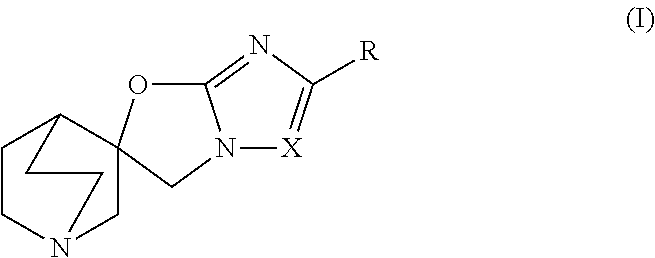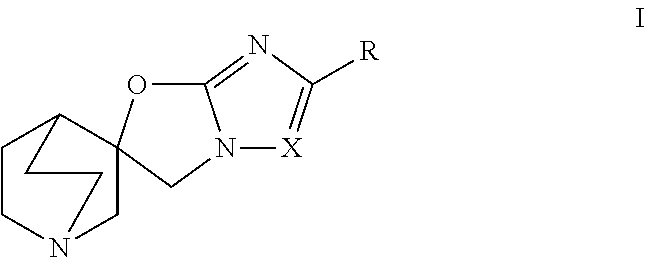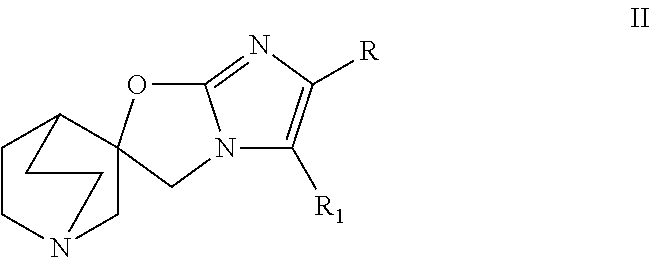Quinuclidine compounds as alpha-7 nicotinic acetylcholine receptor ligands
a technology of nicotinic acetylcholine receptor and quinuclidine, which is applied in the field of substitution of amino oxazolidine quinuclidine compounds, can solve the problems of schizophrenia patients having an elevated risk of suicide, major impairment of mental and social functioning, and the development of other pathologies
- Summary
- Abstract
- Description
- Claims
- Application Information
AI Technical Summary
Benefits of technology
Problems solved by technology
Method used
Image
Examples
reference example 1
[0145]1′-Azaspiro[oxirane-2,3′-bicyclo[2.2.2]octan]-1′yl-4-iumtrihydroborate
[0146]1′-Azaspiro[oxirane-2,3′-bicyclo[2.2.2]octan]-1′yl-4-iumtrihydroborate was synthesized according to WO9903859. The product obtained after drying was a white solid. The product was used in the next step without any further characterization.
example 1
[0147](R)-5,6-Dibromo-3H-1′-azaspiro[imidazo[2,1-b]oxazole-2,3′- bicyclo[2.2.2]octane] and (S)-5,6-dibromo-3H-1′-azaspiro[imidazo[2,1 -b]oxazole-2,3 ′-bicyclo[2.2.2]octane]
[0148]Step A: (5,6-Dibromo-3H-1′-azaspiro[imidazo[2,1-b]oxazole-2,3′- bicyclo[2.2.2]octan]-1′-yl-8-ium)trihydroborate
[0149]To 2,4,5-tribromo-1H-imidazole (2 g, 6.6 mmol) in THF (15 mL) was added N-butyllithium (2.6 mL, 6.6 mmol) dropwise at −78° C. After 45 minutes, a solution of racemic (1′-azaspiro[oxirane-2,3′-bicyclo[2.2.2]octan]-1′-yl-4-iumtrihydroborate (2.0 g, 13 mmol) from the reference example, in THF (15 mL) was added dropwise at −78° C. The cooling bath was removed and the reaction mixture warmed to room temperature. After 15 minutes, the mixture was heated to 70° C. for 2 hours and then cooled to room temperature. The reaction was quenched with water and the product was extracted with ethyl acetate (100 mL). The organics were dried with MgSO4, filtered and the solvent was removed to yield the crude pro...
example 2
[0152](R)-5,6-Dichloro-3H-1′-azaspiro[imidazo[2,1 -b]oxazole-2,3′-bicyclo[2.2.2]octane] and (S)-5,6-dichloro-3H-1′-azaspiro[imidazo[2,1 -b]oxazole-2,3′-bicyclo [2.2.2]octane]
[0153]Step A: (5,6-Dichloro-3H-1′-azaspiro[imidazo[2,1-b]oxazole-2,3′- bicyclo[2.2.2]octan]-1′-yl-8-ium)trihydroborate
[0154]To 2-bromo-4,5-dichloro-1H-imidazole (1 g, 4.6 mmol) in THF (25 mL) was added N-butyllithium (1.85 mL, 4.6 mmol) dropwise at −78° C. After 45 minutes, a solution of racemic (1′-azaspiro[oxirane-2,3′-bicyclo[2.2.2]octan]-1′-yl-4-ium)trihydroborate (0.99 g, 6.5 mmol) from the reference example, in THF (15 mL) was added dropwise at −78° C. The cooling bath was removed and the reaction mixture warmed to room temperature. After 15 minutes, the mixture was heated to 75° C. for 2 hours and then cooled to room temperature. The reaction was quenched with water and the product was extracted with ethyl acetate (100 mL). The organics were dried with MgSO4, filtered and the solvent was removed to yield ...
PUM
| Property | Measurement | Unit |
|---|---|---|
| pH | aaaaa | aaaaa |
| v/v | aaaaa | aaaaa |
| flow rate | aaaaa | aaaaa |
Abstract
Description
Claims
Application Information
 Login to View More
Login to View More - R&D
- Intellectual Property
- Life Sciences
- Materials
- Tech Scout
- Unparalleled Data Quality
- Higher Quality Content
- 60% Fewer Hallucinations
Browse by: Latest US Patents, China's latest patents, Technical Efficacy Thesaurus, Application Domain, Technology Topic, Popular Technical Reports.
© 2025 PatSnap. All rights reserved.Legal|Privacy policy|Modern Slavery Act Transparency Statement|Sitemap|About US| Contact US: help@patsnap.com



